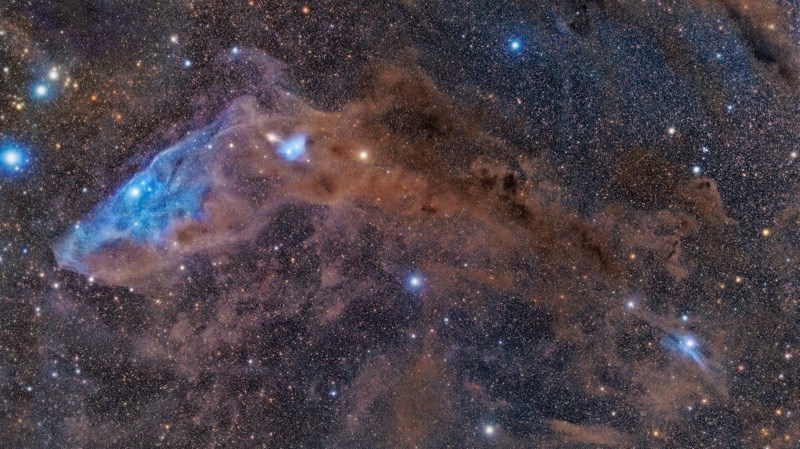2022 Award Winners
Astrophotography Awards 2022
Meet the Judges: Peter Ward and Phil Hart
Deep Sky Image Award
Presented for the best telescopic or camera image of any Deep Sky (non-Solar System) astronomical object, not incorporating a foreground land or seascape.

Deep Sky Image Winner & Overall Best Image Winner: Paul Montague -- The Barred Spiral Galaxy NGC 1398
Sponsored by Adelaide Optical Centre
Paul Montague’s stunning image of NGC 1398 won him the 2022 ASSA Astrophotography Deep Sky Image Award and the Overall Best Astrophotography Award.
NGC 1398 is an isolated barred spiral galaxy exhibiting a double ring structure. It is located 65 million light years distant, in the constellation Fornax. The judges Phil Hart and Peter Ward noted this image has been well captured and has been processed with great skill. Not overdone, and not pushed too hard. Technically very well handled, leaving the galaxy with a very natural appearance. This is not easy to do. The image draws the viewer into the core, to examine the detail. it is a compelling and attractive image. Congratulations Paul!
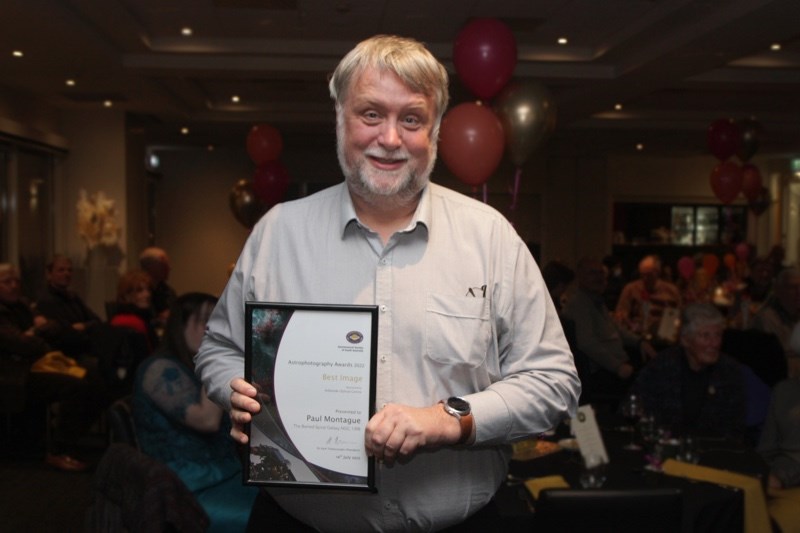
Paul Montague
Highly Commended Entries
Jarrod Koh -- My Horse Bluey
This object is a blue reflection nebula, at approx 400 light years distant, largely illuminated by the star Nu Scorpii positioned at the "eye", with other smaller reflection nebulae also to be seen within the body.
Dust lanes are well captured and the colour has been nailed. It is very challenging to process such wide field images. This image has a high visual impact and makes you want to cross the room to take a closer look. Congratulations Jarrod!.
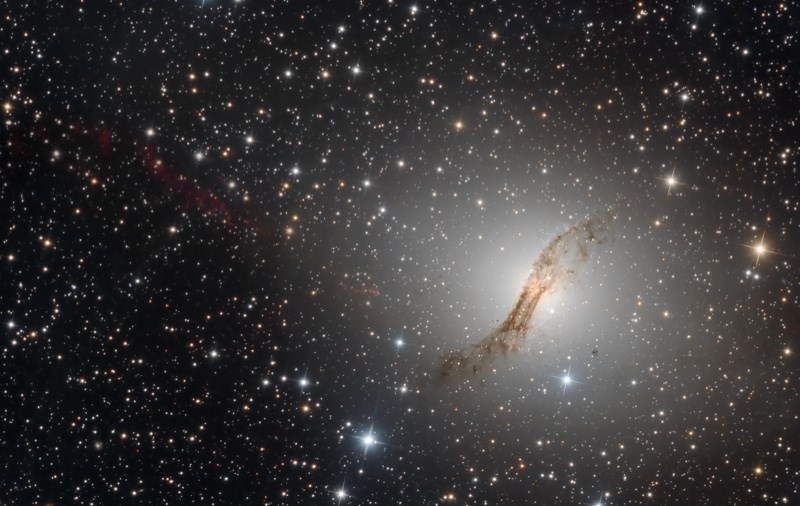
Paul Montague -- Cennie and the Jets
This object, catalogued as NGC 5128, is better known as the Hamburger Galaxy. It lies in the constellation Centaurus at an approx. distance of 12 million light years, and has a super-massive black hole at its core. The galaxy was first discovered by the Scottish astronomer James Dunlop from the Paramatta observatory in New South Wales in Australia on August 4, 1826. To radio astronomers it is also famous as Centaurus-A, the most prominent extra-galactic radio source in the sky, first identified using an interferometer at Dover Heights in Australia in 1948-49.
This is a very deep image -- a staggering exposure duration of almost 68 hours, and revealing the elusive jet, and outer structures. Congratulations Paul!
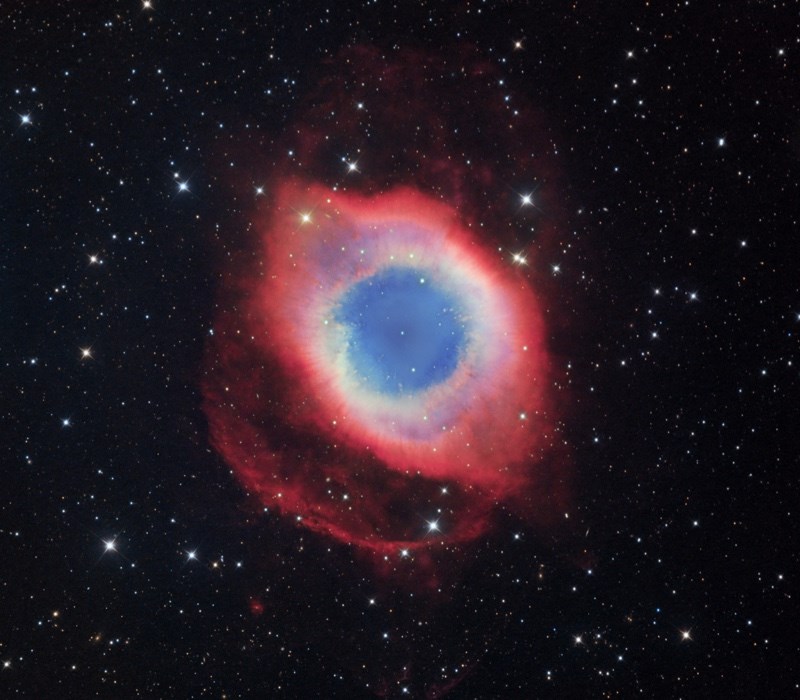
Paul Haese -- Helix
This object, catalogued as NGC 7293, is a planetary nebula in the constellation Aquarius, at approximately 650 light years distance. A planetary nebula (so called due to its rounded planetary appearance) is formed when the central star has run out of fuel and expands, and "puffs off" its outer layers, before collapsing to become a white dwarf star.
This is a very deep image of 44 hours exposure. The relatively long focal length used requires high technical skills to achieve the sharpness as seen. The image displays well preserved shadow and highlight detail, and is well processed resulting in an image that has respected the light.

Paul Haese -- M78 Darkness and Light
Messier 78 (M78) also known as NGC 2068, is a reflection nebula in the constellation Orion. It was included by Charles Messier in his catalog of comet-like objects, after being discovered by Pierre Méchain in 1780. This dusty region is approximately 1350 light years distant.
This is a difficult target to image with high dynamic range. The frame is filled with considerable colour and detail. The reflection and emission nebulae have both been captured with the blue reflection nebula handled very well. Congratulations Paul!
Solar System Image Award
Presented for the best image of any Solar System object, including the Sun, Moon, planets, natural satellites, and comets.
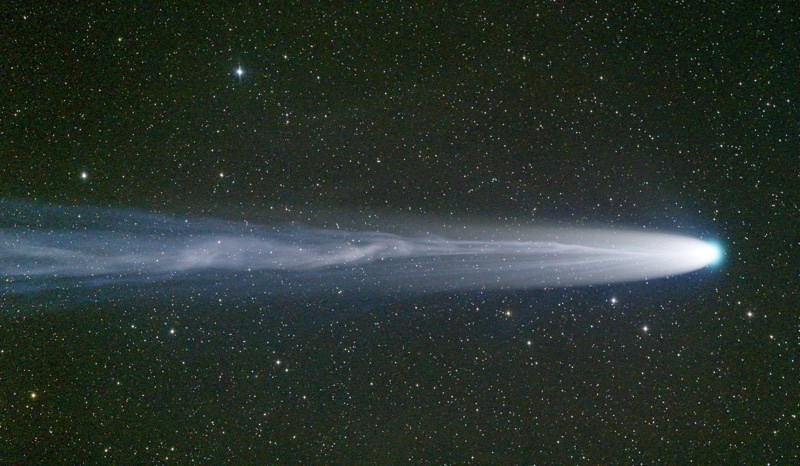
Solar System Image Winner: Michael Mattiazzo -- Comet C/2021 A1 Leonard (28 Dec 2021)
Sponsored by Bintel
This long-period comet was discovered by G. J. Leonard at the Mt Lemon Observatory (USA) on 3 January 2021. The comet had its closest approach to the Sun exactly one year later, and during its closing approach in December, experienced a number of outbursts that made it the brightest comet for 2021 with a spectacular tail that extended many degrees.
Of all the images in the Solar System category, the comet images stood out as being the most difficult to capture, being relatively faint objects, but with fast evolving detail requiring short exposure times. This image displays the best colour balance, with the most even illumination across the field. This subject is technically difficult to deal with, and has been well captured here. Congratulations Michael!
Nightscape Image Award
Presented for the best widefield image, incorporating foreground land or seascapes, of astronomical objects such as aurora, lunar or planetary conjunction, comet, constellation, or the Milky Way.

Nightscape Image Winner: Ian Inverarity -- Been Here a While Under the Stars
Sponsored by Adelaide Optical Centre
Captured at Arkaba Creek north of Hawker, South Australia. This 3-shot vertical panorama is an enigmatic image that could be framed and put on a wall. It is very pleasing to look at with the Milky Way in the background. The illumination has been well handled. Congratulations Ian!
Highly Commended Entries

Jarrod Koh -- Aurora over Rosetta Head
The image is a blended panorama of 6 separate photos taken in portrait mode. The image is noteworthy for its very wide field of view used to capture not only a rare and beautiful aurora but also Barnard's Loop circling Orion (left hand side). Congratulations Jarrod!
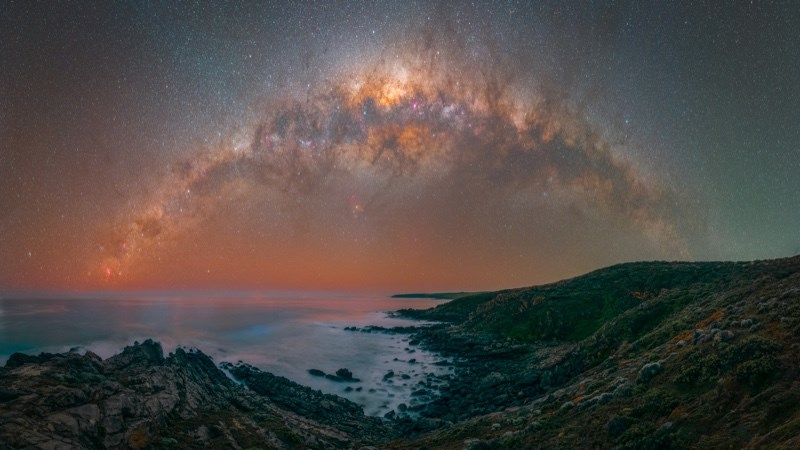
Will Godward -- Southern Glow
A 30-image panorama taken at Parsons Beach, South Australia.
A fine image, well executed.
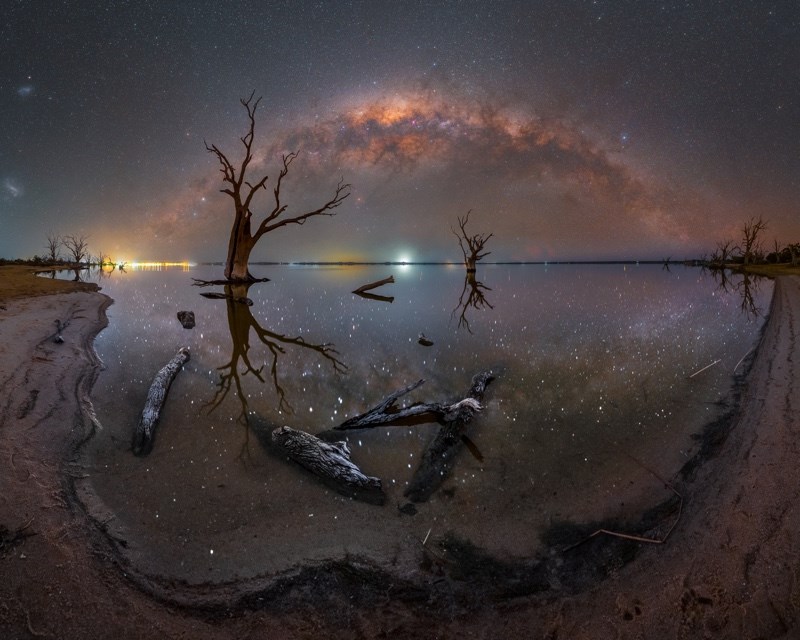
Will Godward -- Nookampa
A 30-image panorama taken at Lake Bonney, South Australia.
Also a fine image, well executed.
Timelapse Video Award
Presented for the best video or timelapse (animated) sequence of images of any celestial scene or event.
Timelapse Video Winner: Will Godward -- Lake Bonney Milky Way
Sponsored by Adelaide Optical Centre
This timelapse sequence has been well captured and is a very aesthetically pleasing presentation, highlighting the reflections of the main subject in the still water. The delicate zooming effect adds extra interest. Overall, very well done. Congratulations Will!
Highly Commended Entry
Will Godward -- Lake Bonney Lunar Eclipse 2021
This timelapse sequence of the May 2021 Total Lunar Eclipse over Lake Bonney, South Australia, was Highly Commended in the ASSA Astrophotography Awards 2022. The judges comments included that it tells a story very well and has respected the light. The time-lapse was well captured despite extreme dynamic range. The author appears to have deliberately chosen to not adjust exposure in order to tell the story. Congratulations Will!
Junior Astrophotography Award
Presented to an entrant 18 years or younger at the time of submission, and selected from all eligible entries received.
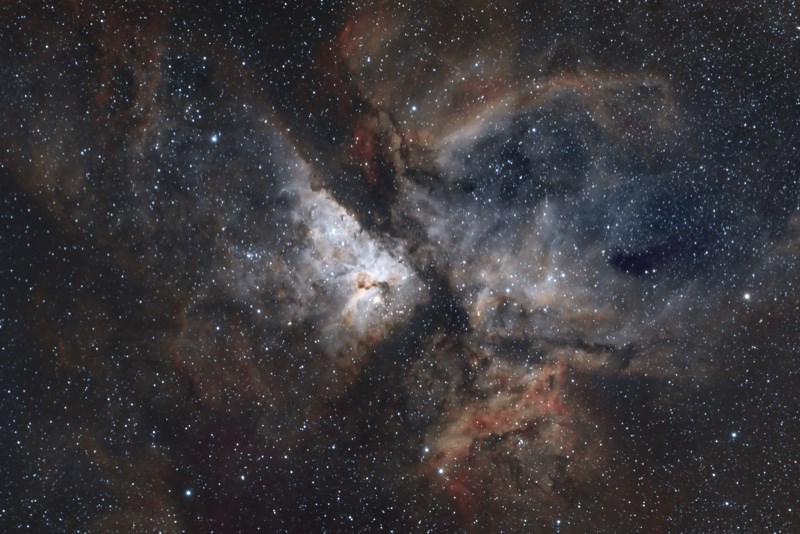
Winner: Anthea Wills -- Tim Tam Slam
Sponsored by the Astronomical Society of South Australia
The Eta Carinae Nebula, catalogued as NGC 3372, is a showpiece of the southern sky, with its full extent covering several degrees of sky despite its distance of approximately 8,500 light years. This nebula is one of the largest star forming regions in the Milky Way.
To set the scene for this Junior Astrophotography Award... Astrophotography is difficult. One must point the telescope at something that cannot be seen, track it, and get a sharp image. The winner has been chosen because the author has displayed mastery of these basic skills in capturing and processing, to produce a creditworthy image. This image stands out among the others in this section. With a 4 hour exposure, noise has been well handled to produce a great outcome. This is a good strong representation of the Carina Nebula. Congratulations Anthea!
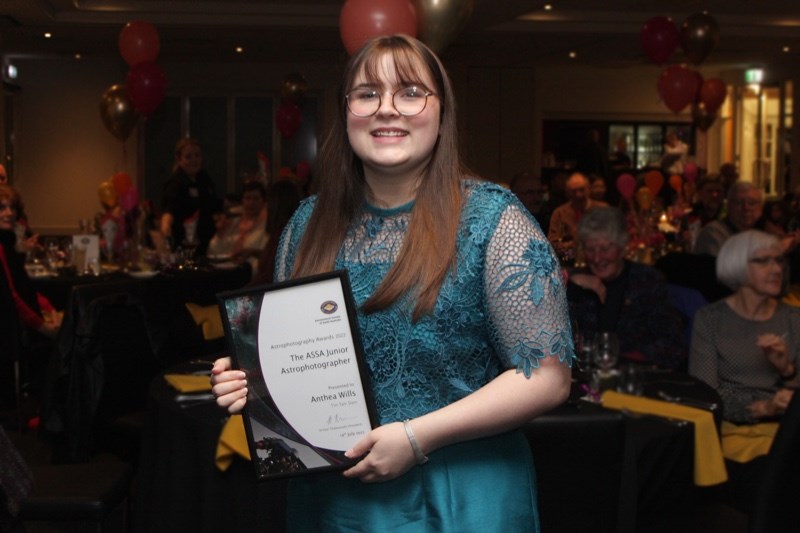
Anthea Wills
Craig Richardson Memorial Award
Selected by the Richardson family from the Nightscape and Timelapse Video entries received involving a land or seascape foreground. Craig Richardson was a keen and active member of the ASSA from the late 1980's until 2001 and best known for his enthusiastic approach to the observation and photography of the Aurora Australis, or Southern Lights.

Winner: Jarrod Koh -- Aurora over Rosetta Head
Sponsored by The Richardson Family
The image is a blended panorama of 6 separate photos taken in portrait mode. The image is noteworthy for its very wide field of view used to capture not only a rare and beautiful aurora but also Barnard's Loop circling Orion (left hand side) together with hints of the Horsehead Nebula -- one of Craig's favourite celestial objects. Congratulations Jarrod!
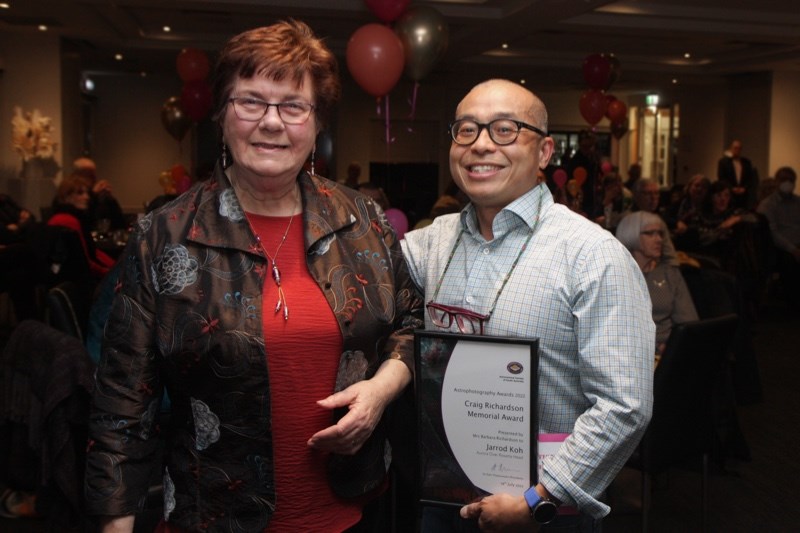
Barbara Richardson and Jarrod Koh
Editor's Award
The Editor's Award is given annually by the Editor of The Bulletin for the best original article or original series of articles by a member and published in the Society's news letter in the membership year. The article (or series of articles) must be of single authorship of 50 words or more.
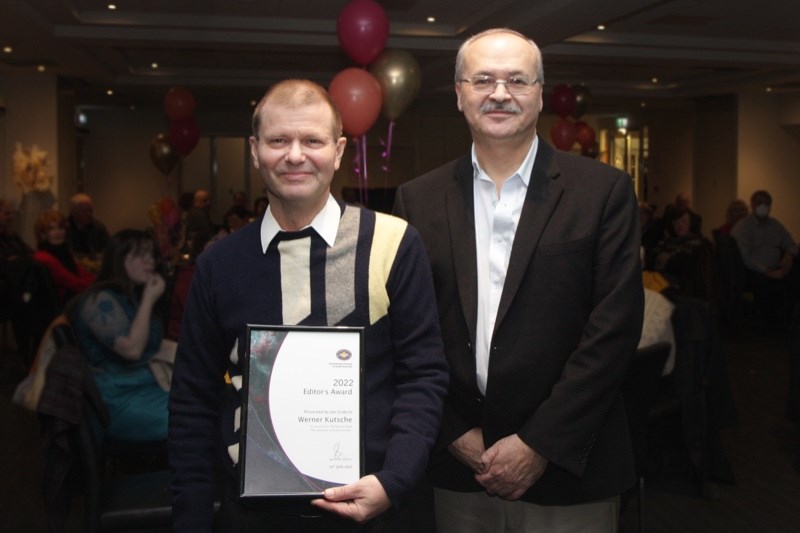
Werner Kutsche and Joe Grida
For his article “My Telescope: A 33 Year Journey”, The Bulletin, September 2021, in which Werner tells of the reconstruction of a life-long friend, his 8-inch Dobsonian telescope. In true amateur style, he recounts the endless hours of stargazing he has enjoyed with the telescope, and also the spartan way he went about the refurbishment.
Congratulations Werner!
Annual Service Awards
The Annual Service Award is given to a current member in recognition of their service to the Society over several years up to and including the current membership year.
[photo to be supplied]
Michael Chartres
In recognition of innovative contributions to the development of engaging astronomical activities and displays at the ASSA Science Alive! exhibit in 2021.
Congratulations Michael!
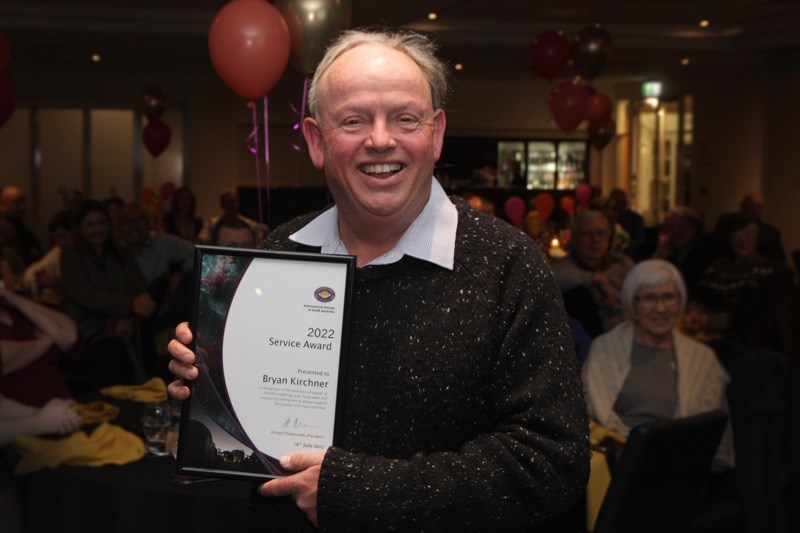
Bryan Kirchner
In recognition of the provision of supper at monthly meetings over many years and an unwavering willingness to always support the Society in its many activities.
Congratulations Bryan!
[photo to be supplied]
Paul Martinaitis
In recognition of contributions to members and the general public by sharing knowledge of observational astronomy via ASSA@Home and The Sky this Month.
Congratulations Paul!
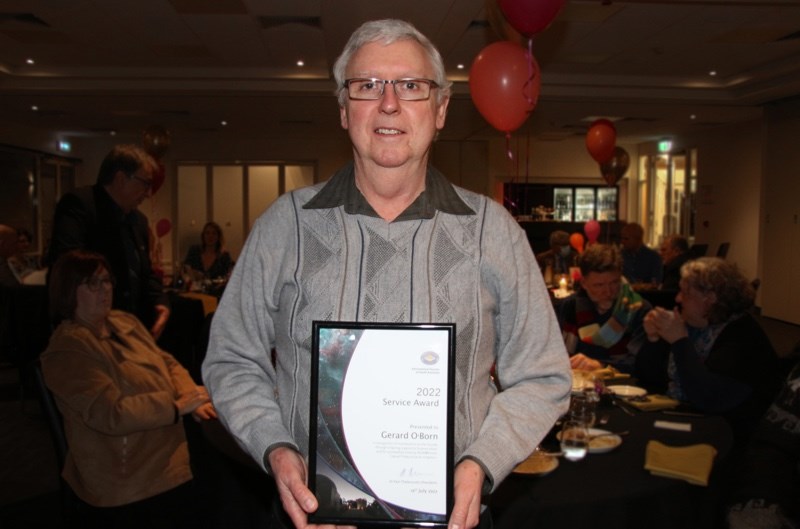
Gerard O'Born
In recognition of contributions to the Society through ongoing support to Science Alive! and for successfully hosting the ASSA Casual Friday online show since its inception.
Congratulations Gerard!
